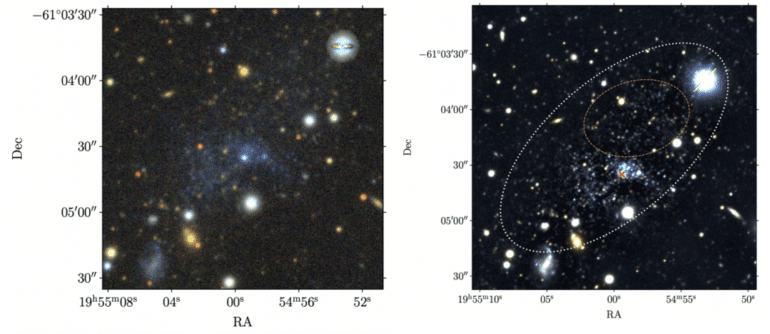TL;DR:
- Dwarf galaxies offer insights into the early universe and star formation.
- Reionization impacted small dwarf galaxies’ star formation.
- Identifying isolated dwarf galaxies is crucial for research.
- Pavo, a distant dwarf galaxy, was discovered using machine learning.
- Pavo’s stars reveal multiple generations and their distance from the Milky Way.
- Pavo’s isolation makes it an intriguing study subject for star formation.
- Future space-based observations promise more insights into Pavo and similar galaxies.
Main AI News:
In the realm of understanding the universe’s history, dwarf galaxies emerge as small yet potent players. They offer a glimpse into the appearance of galaxies during the early universe, serve as laboratories for investigating how gas exchange with neighboring galaxies affects star formation, and have intrigued astronomers for years due to the discord between observations and predictions regarding the number of dwarf galaxies in our galactic vicinity.
Dwarf galaxies played a pivotal role in the early universe by contributing to the Epoch of Reionization, where the light from the first generation of stars ionized neutral hydrogen gas throughout the cosmos. However, the heating of their hydrogen gas during reionization stifled star formation in some small dwarf galaxies, as cold, dense star-forming clouds either evaporated or became excessively hot. The question arises: What size of dwarf galaxies can be quenched by reionization?
Answering this question proves challenging, as many dwarf galaxies are closely situated to other galaxies. Even if reionization shut down their star formation, gas inflows from neighboring galaxies could reignite it. To tackle this issue, researchers turn their attention to identifying relatively isolated dwarf galaxies. Extensive surveys have led to the discovery of numerous ultra-faint and low-mass galaxies with individually distinguishable stars. However, finding more isolated dwarfs may necessitate venturing beyond our galaxy’s immediate vicinity, known as the Local Group, where the stellar populations are only partially resolved.
Today’s authors employ machine learning algorithms to comb through existing surveys, revealing a small dwarf galaxy on the outskirts of the Local Group – a significant discovery.
Examining a Distant Neighbor Up Close
To locate low-mass, isolated dwarf galaxies, the authors leverage data from the Dark Energy Camera Legacy Survey (DECaLS), the Mayall z-band Legacy Survey (MzLS), and the Beijing Arizona Sky Survey (BASS). These surveys encompass vast swathes of the sky, requiring the authors to employ a convolutional neural network classifier named SMUDGes, trained on both good and bad examples of dwarf galaxy candidates within a relatively small 150 square degree region of the sky. After identifying galaxies using SMUDGes, volunteers at Zooniverse categorize galaxy candidates, focusing on nearby, low-mass galaxies with partially resolved stars. Among these, a remarkable and solitary galaxy named Pavo, residing in the constellation of the same name, stands out.
Subsequently, the authors gather additional images of Pavo using the Inamori-Magellan Areal Camera & Spectrograph (IMACS) to obtain a closer look at its stars. They also utilize UV images from the Swift Observatory to gauge its star formation rate, as UV emission traces younger stars, and H-alpha images from the Southern Astrophysical Research Telescope to search for star-forming regions, as H-alpha emanates from excited hydrogen gas surrounding massive young stars.
Learning from the Stars
Pavo’s stars reveal intriguing insights into its history. In the IMACS image of Pavo, generated by combining g and r filters, many of its stars can be individually discerned. Pavo’s blue appearance in the DECaLS imaging indicates a population of younger, hotter stars emitting bluer wavelengths. However, the new IMACS image unveils an older, redder group of stars, suggesting that multiple generations of stars coexist within this galaxy. While Pavo seemingly endured reionization with its young blue stars, its star formation history over the past ten million years remains less clear. H-Alpha observations fail to detect star-forming regions in Pavo. Though there may be very young stars in Pavo that are insufficiently massive to ionize surrounding gas, its UV star formation rate implies a cessation of star formation in the past ten million years.
Pavo’s stars also provide clues about its distance from our galaxy. By examining stars in the later stages of their lives, specifically those at the tip of the red giant branch (TRGB), astronomers can determine their distance and the galaxy they belong to. Employing this method, the authors establish that Pavo is roughly two million parsecs away from the Milky Way, approximately three times the distance to the Andromeda galaxy. This places Pavo in a relatively isolated position, with its closest neighbor residing 600 thousand parsecs away, making it one of the most isolated low-mass dwarf galaxies discovered to date.
The authors anticipate that future, higher-resolution space-based observations will provide a more detailed view of Pavo’s stellar populations, shedding further light on its star formation history. Pavo, having likely never experienced significant interactions with more massive galaxy neighbors, serves as an intriguing case study for understanding star formation in the lowest mass galaxies. With upcoming large-area surveys using instruments like the Roman Space Telescope and the Vera C. Rubin Observatory, many more systems akin to Pavo are expected to surface, including even lower mass, isolated galaxies potentially quenched by reionization. The use of machine learning to identify such distant and faint dwarf galaxies with unresolved stellar populations extends the frontiers of galactic exploration, offering the possibility of discovering numerous counterparts to Pavo, even if Pavo itself remains an isolated sentinel at the edge of the Local Group.
Conclusion:
The discovery of Pavo, an isolated dwarf galaxy, highlights the importance of identifying and studying such galaxies for understanding the early universe and star formation. This discovery, facilitated by machine learning, suggests a growing potential for uncovering more galaxies like Pavo in the future. These findings could influence the market for astronomical research tools and technologies, as demand for higher-resolution observations and advanced machine learning algorithms is likely to increase.

